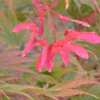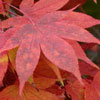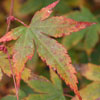| ACER palmatum
'Orange Dream'
This recent Italian introduction is unique. The spring growth is orange (though less vivid than 'Katsura') followed by wonderful rich golden summer colour. Resplendent red and orange autumn colours complete the display. Upright habit and vigorous when young. Not the easiest plant to site as too much shade will loose the intensity of colour whilst too much sun can bleach or even burn them, but worth the effort to get it right. 4m We seldom propagate this one because of the difficulties in growing it on our exposed site. |
||
|
|
||
ACER palmatum 'Oranges and Lemons' Essentially green-leaved, the name was chosen to reflect the opposite ends of the season, with acid green young growth and orange autumn colour. Initially slender and upright in habit, this robust small tree will broaden with age, though maintaining an open habit. |
||
|
|
||
ACER palmatum 'Oregon Sunset' Coming soon... |
||
|
|
||
| ACER palmatum
'Oridono nishiki'
Perhaps the most reliable variegated cultivar in its group, but still difficult to grow in our exposed conditions, so unlikely to be regularly available. Lots of pink bits, even on strong growing young plants! A handsome dense shrubby tree. 3m. |
||
|
|
||
ACER palmatum 'Oriental Glory' This is a handsome plant. The comparatively large leaves unfurl a rich shade of purplish red, maturing to purple through the summer. Autumn colours include bright reds and oranges. It has a free-branching habit, developing into an open, broad canopied small tree. An extra feature that I particularly enjoy is its lovely bark. |
||
|
|
||
 |
ACER palmatum
'Õ sakazuki'
One of the best palmatums for autumn colour, with fiery displays of crimsons and oranges lasting for two weeks or more. At potentially 10cm across, the leaves are some of the biggest too, flushed rose when opening before becoming rich green. Beware of inferior seedlings! Our material originally came from the beautiful mature trees at the Savill Gardens, Windsor. The photo here shows the amazing seeds which are reliably produced by this cultivar. 4m |

|
|
|
||
 |
ACER palmatum
'Oshû
beni' |
|
|
|
||
| ACER palmatum
'Oshû shidare'
A wonderful plant of distinct cascading habit as 'Omureyama'. The purple leaves of spring become bronze purple with green undertones in summer, and red in autumn. Very rare! |
||
|
|
||
 |
ACER palmatum
'Oto hime' Very similar to Acer palmatum 'Komache hime', 'Mapi-no-machi hime' or 'Murasaki kiyohime' A compact growing shrub, which is surprisingly vigorous when young. The fresh green leaves develop yellow autumn colours, then leave a wonderfully architectural structure once they drop. |
|
|
|
||
 |
ACER palmatum
'Otome zakura'
At first glance, this small bushy tree is very much in the same vein as 'Corallinum' - however, there is more to it than that! It has the same wonderful bright pink new growth, which is held well for several weeks before turning into a maroon red. As is often the case, the exact colour will be influenced, if not determined, by the light levels. Colours will be richer in a sunny site. The difference is in the shape of the leaves - there are two kinds on the same tree. Larger, typically palmatum shaped leaves occur on newer, more vigorous shoots. The centre lobes are larger with the side lobes much smaller, separated two-thirds of the way to the leaf base. On older, more twiggy shoots, the leaves are completely different; having long narrow lobes that are almost parallel and only slightly broader in the middle. |
|
|
|
||
 |
ACER palmatum
'Peaches and Cream'
I love this one! It was selected as a seedling from 'Shigitatsu sawa' in Australia in 1980. The familiar reticulate variegation is overlaid with tones of pink and salmon. Shrubby in growth, the pale foliage lacks chlorophyll which makes it vulnerable to too much sun - best in dappled shade therefore, but surprisingly tolerant even so. 1-2m See it in our Lower Maple Glade. |
|
|
|
||
|
ACER palmatum 'Phoenix' It is silly to have two acers with the same cultivar name, but of different species. Do not confuse this one with the snakebark of the same name therefore. This one does not have the same winter bark interest as its namesake, but it does have superb apricot-pink young growth as the leaves first open in the spring. It took a while to establish, as indeed do all these forms with highly coloured foliage, but they are now growing well and doing themselves justice. Nevertheless, a slightly sheltered site with good soil is probably safer. 2m See it in our Maple Glade. |
||
|
|
||
| ACER
palmatum 'Purple Ghost'
This spectacular maple is the darkest of acclaimed Oregon nurseryman Talon Buchholz's Flora Wonder introductions. The spring leaves are deep purple-red with prominent veins so dark as to be almost black, fading to purple with the familiar pale ghostly interspaces through the summer, though the exact effect will be influenced by light levels. The autumn colours are potentially spectacular with shades of fiery reds and oranges. For me this is making a shrubby small tree to some 2m tall by a little less in 10 years. |
||